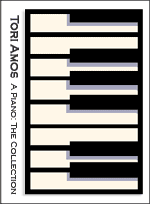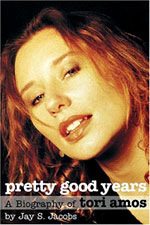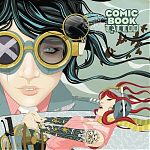- Articles
- Cherries
- Minutiae
- Q&A
- RAINN
- Releases
- Reviews
- Site News
- Them
- Toriphiles
- Touring
- TV/Radio/Web
- Video
News Archives
Keep an eye on our Twitter and Facebook pages since we often post quickie updates there when we're on-the-go.
During tours, we do our best to cover setlists in real-time on Twitter. If you want to tweet a show in, just DM or @ us on the day and tell us to watch your stream that night.
Tori is touring in 2017 to support the release of Native Invader. The European legs runs from early September through early October and the North American leg runs from late October to early December. We do not know if additional dates elsewhere will be added.

Native Invader (album, 2017)

Unrepentant Geraldines (album, 2014)

Gold Dust (album, 2012)

Night of Hunters (album, 2011)

Midwinter Graces (album, 2009)
 Abnormally Attracted To Sin (album, 2009)
Abnormally Attracted To Sin (album, 2009)
Live at Montreux 1991/1992 (DVD, 2008)

American Doll Posse (album, 2007)

A Piano (boxed set, 2006)

Pretty Good Years
(bio, 2006)

Fade To Red
(DVD, 2006)
 Comic Book Tattoo (book, 2008)
Comic Book Tattoo (book, 2008)News: Time Out Sydney Interview (November 2014)
The mistake happens when an artist thinks that they’re the ones doing a nice thing. We get into this weird arrogance. Instead of saying “this is a gift.” These people have waited in line and they’re going to bring you something, they’re going to bring you a perspective for tonight’s show that you need for it to be different. They are bringing you emotional gold and if you understand this then you won’t be foolish.
In a brief interview for Time Out Sydney, which is included in their web listings for all three of this month’s Sydney stops on the Unrepentant Geraldines Tour’s Australian leg, the subject is, unsurprisingly, touring: from her approach to performing to her thoughts on covers and selecting which ones to include in her set but she also touches on the art of the meet and greet and how she was groomed for them by her upbringing.
Thanks mkgtweety for the link!
Tori Amos
11-12 Nov, Alternative, Around Town, Concert Hall, Gigs, Music, Sydney
The endearingly offbeat singer-songwriter explains why she loves doing covers and how she became a lifelong people pleaser
Tori Amos will perform two concerts at the Opera House this month, accompanied by the Sydney Symphony Orchestra – and not, thankfully, the dreadful piano hold music that precedes our interview. “Yeah,” she laughs, “I was listening to that too and thinking, ‘How in the world did that ever get anywhere?’ Just shocking. Who picked that?”
Tori, have you ever come across your own songs as hold music?
No, nor at a dentist office, nor in elevators. I think maybe that’s a good thing.
It’s not unusual to find you at the Sydney Opera House, though.
I love it. The Opera House, the Royal Albert Hall in London, Radio City in New York – these places carry huge mythology. Backstage where the artist gets their dressing room [at the Opera House] is right on the harbour! You’re watching the boats go by and you have a piano in your room and you’re trying to ground yourself before you go out and play.
What does that involve?
The wife and mother that I am, she stays back in the dressing room having a cup of tea and watching the boats go by. She’s very happy doing that and then the musician walks out. You have to become more of a container for the music. You have to be really focused, in order to be present with it, to be responding to the audience and able to change in a millisecond.
You are famous for including covers in your performances.
I think people like variations on things. It’s just something in our DNA – we’re drawn to them. I didn’t set out to [do covers, but] I knew I needed to do something so people wouldn’t get bored. The one thing you can do when you’re a solo performer is really change the show. So that was kind of the driving force – to keep it interactive. People turn up at the stage door and say, ‘I think you’d do a really good cover of this song…’
How do you decide which songs to cover?
You have to be quite vicious with the whole thing. There has to be some type of neutrality that you bring to it so that you can realise: I don’t have anything to bring to this. Just because you might like it doesn’t mean for one second you should be doing it. [On the other hand], sometimes people will recommend things to me that I don’t know, so I don’t really have a relationship with it but I’m intrigued… so I’ll take it on board.
Are those audience requests part of your symphonic show?
Absolutely. But it doesn’t always work because sometimes you’re doing a radio show so that gets in the way. I try and do it as often as I can because you learn a lot. The mistake happens when an artist thinks that they’re the ones doing a nice thing. We get into this weird arrogance. Instead of saying “this is a gift.” These people have waited in line and they’re going to bring you something, they’re going to bring you a perspective for tonight’s show that you need for it to be different. They are bringing you emotional gold and if you understand this then you won’t be foolish.
Where did you learn that approach?
Of all people, it was my parents. After my father would preach on Sunday – and those sermons could get a little long and cut into the NFL games which would make people very antsy – to torture people even more they would stand outside the door and shake everybody’s hand that came to the service. And we had to stand there with them: me, my brother, and sister. I remember greeting people from when I was two years old. It just became part of my life.


